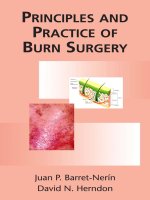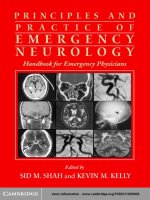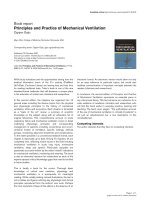Principles and Practice of Burn Surgery pptx
Bạn đang xem bản rút gọn của tài liệu. Xem và tải ngay bản đầy đủ của tài liệu tại đây (9.23 MB, 426 trang )
DK1132_half 9/1/04 9:43 AM Page 1
PRINCIPLES AND
PRACTICE OF
BURN SURGERY
DK1132_title 9/1/04 9:41 AM Page 1
PRINCIPLES AND
PRACTICE OF
BURN SURGERY
Juan P. Barret-Nerín, M.D.
St. Andrew’s Centre for Plastic Surgery and Burns,
Broomfield Hospital, Essex, United Kingdom
David N. Herndon, M.D.
Galveston Shriners Hospital, Texas
University of Texas Medical Branch, Houston, Texas
MARCEL DEKKER NEW YORK
Although great care has been taken to provide accurate and current information, neither
the author(s) nor the publisher, nor anyone else associated with this publication, shall be
liable for any loss, damage, or liability directly or indirectly caused or alleged to be caused
by this book. The material contained herein is not intended to provide specific advice or
recommendations for any specific situation.
Trademark notice: Product or corporate names may be trademarks or registered trademarks
and are used only for identification and explanation without intent to infringe.
Library of Congress Cataloging-in-Publication Data
A catalog record for this book is available from the Library of Congress.
ISBN: 0-8247-5453-0
This book is printed on acid-free paper.
Headquarters
Marcel Dekker, 270 Madison Avenue, New York, NY 10016, U.S.A.
tel: 212-696-9000; fax: 212-685-4540
Distribution and Customer Service
Marcel Dekker, Cimarron Road, Monticello, New York 12701, U.S.A.
tel: 800-228-1160; fax: 845-796-1772
World Wide Web
The publisher offers discounts on this book when ordered in bulk quantities. For more
information, write to Special Sales/Professional Marketing at the headquarters address
above.
Copyright 2005 by Marcel Dekker. All Rights Reserved.
Neither this book nor any part may be reproduced or transmitted in any form or by any
means, electronic or mechanical, including photocopying, microfilming, and recording,
or by any information storage and retrieval system, without permission in writing from
the publisher.
Current printing (last digit):
10987654321
PRINTED IN THE UNITED STATES OF AMERICA
To my wife Esther, who is everything;
to my daughter Julia, who is even more;
and to my parents,
Juan Pedro (1933–2004) and Adelaida, who made me who I am.
Juan P. Barret
Preface
With an overall incidence of more than 800 cases per 1 million persons per year,
only motor vehicle accidents cause more accidental deaths than burns. Advances
in trauma and burn management over the past three decades have resulted in
improved survival and reduced morbidity from major burns. Twenty-five years
ago, the mortality rate of a 50% body surface area burn in a young adult was
about 50%, despite treatment. Today, that same burn results in less than 10%
mortality. Ten years ago, an 80 to 90% body surface area burn yielded 10%
survival. Today, over 50% of these patients survive.
Nevertheless, although burn injuries are frequent in our society, many phy-
sicians feel uncomfortable managing patients with thermal injuries. Excellent
textbooks about the pathophysiology of thermal injury and inhalation injury have
recently been published. All new data produced by active research in the field
of burn and trauma can be found in these books. Yet, the state-of-the-art tech-
niques in the day-to-day care of burn patients—either as outpatients, in the operat-
ing room, or in the burn intensive care unit—have yet to be outlined in a single
volume.
The current project includes all current techniques available today for the
care of burn patients. Improved results in survival are due to advancements in
resuscitation, operative techniques, infection control, and nutritional/metabolic
support. All these improvements are included in the book, along with all the
available techniques for burn shock treatment, hypermetabolic response support,
new hemostatic and skin substitutes, and pain and psychology support and rehabil-
itation.
General surgeons, plastic surgeons, medical and surgical residents, emer-
gency room physicians, senior students, and any kind of physician or burn team
v
Prefacevi
member involved in burn treatment in either community hospitals or burn centers
would benefit from the present book, which not only outlines the basics of burn
syndrome but also provides an overview of options for burn treatment. The book
has been organized in a stepwise manner, with clear information as if the reader
would be involved in weekly grand round, day-to-day work with the burn surgeon,
anesthetist, or any other burn team member. We sincerely hope that it will serve its
purpose of establishing the main principles of surgical treatment of burn injuries.
Juan P. Barret
David N. Herndon
Contents
Preface v
Contributors ix
1. Initial Management and Resuscitation 1
Juan P. Barret
2. General Treatment of Burned Patients 33
Juan P. Barret
3. Diagnosis and Treatment of Inhalation Injury 55
Lee C. Woodson, Ronald P. Mlcak, and Edward R. Sherwood
4. Burn Wound Management and Preparation for Surgery 85
Juan P. Barret and Peter Dziewulski
5. Anesthesia for Acute Burn Injuries 103
Lee C. Woodson
6. Principles of Burn Surgery 135
David M. Heimbach and Lee D. Faucher
7. Management of Superficial Burns 163
Juan P. Barret and Peter Dziewulski
vii
Contentsviii
8. The Small Burn 187
Juan P. Barret
9. The Major Burn 221
Steven E. Wolf
10. Surgical Approaches to the Major Burn 249
Juan P. Barret
11. The Hand 257
Toma
´
sGo
´
mez-Cı
´
a and Jose
´
I. Ortega-Martı
´
nez
12. The Face 281
Juan P. Barret
13. Burn Wound Care and Support of the Metabolic Response to Burn
Injury and Surgical Supportive Therapy 291
Kevin D. Murphy, Jong O. Lee and David N. Herndon
14. A Practical Approach to Acute Burn Rehabilitation 317
Michael A. Serghiou and Scott A. Farmer
15. Psychosocial Support 365
Walter J. Meyer III and Patricia Blakeney
Index 395
Contributors
Juan P. Barret, MD, PhD Broomfield Hospital, Chelmsford, Essex, United
Kingdom
Patricia Blakeney Shriners Burns Hospital, Galveston, Texas, U.S.A.
Peter Dziewulski Broomfield Hospital, Chelmsford, Essex, United Kingdom
Scott A. Farmer Shriners Burns Hospital, Galveston, Texas, U.S.A.
Lee D. Faucher University of Washington Burn Center, Seattle, Washington,
U.S.A.
Toma
´
sGo
´
mez-Cı
´
a Hospital Universitario Virgen del Rocı
´
o, Seville, Spain
David M. Heimbach University of Washington Burn Center, Seattle, Washing-
ton, U.S.A.
David N. Herndon Shriners Hospital for Children and The University of the
Texas Medical Branch, Galveston, Texas, U.S.A.
Jong O. Lee Shriners Hospital for Children and The University of the Texas
Medical Branch, Galveston, Texas, U.S.A.
Walter J. Meyer III Shriners Burns Hospital, Galveston, Texas, U.S.A.
ix
Contributorsx
Ronald P. Mlcak Shriners Hospitals for Children–Galveston and the Univer-
sity of Texas Medical Branch, Galveston, Texas, U.S.A.
Kevin D. Murphy Shriners Hospital for Children and The University of the
Texas Medical Branch, Galveston, Texas, U.S.A.
Jose
´
I. Ortega-Martı
´
nez Hospital Universitario Virgen del Rocı
´
o, Seville,
Spain
Michael A. Serghiou Shriners Burns Hospital, Galveston, Texas, U.S.A.
Edward R. Sherwood Shriners Hospitals for Children–Galveston and the Uni-
versity of Texas Medical Branch, Galveston, Texas, U.S.A.
Steven E. Wolf The University of Texas Medical Branch, Galveston, Texas,
U.S.A.
Lee C. Woodson Shriners Hospitals for Children–Galveston and the University
of Texas Medical Branch, Galveston, Texas, U.S.A.
1
Initial Management and Resuscitation
Juan P. Barret
Broomfield Hospital, Chelmsford, Essex, United Kingdom
INTRODUCTION
Trauma can be defined as bodily injury severe enough to pose a threat to life,
limbs, and tissues and organs, which requires the immediate intervention of spe-
cialized teams to provide adequate outcomes. Burn injury, unlike other traumas,
can be quantified as to the exact percentage of body injured, and can be viewed
as a paradigm of injury from which many lessons can be learned about critical
illness involving multiple organ systems. Proper initial management is critical
for the survival and good outcome of the victim of minor and major thermal
trauma. However, even though burn injuries are frequent in our society, many
surgeons feel uncomfortable in managing patients with major thermal trauma.
Every year, 2.5 million Americans sustain a significant burn injury, 100,000
are hospitalized, and over 10,000 die. Only motor vehicle accidents cause more
accidental deaths than burns. Advances in trauma and burn management over the
past three decades have resulted in improved survival and reduced mortality from
major burns. Twenty-five years ago, the mortality rate of a 50% body surface
area (BSA) burn in a young adult was about 50%, despite treatment. Today, that
same burn results in a lower than 10% mortality rate. Ten years ago, an 80–90%
BSA burn yielded 10% survival. Today, over 50% of these patients are surviving.
Improved results are due to advancements in resuscitation, surgical techniques,
infection control, and nutritional/metabolic support.
1
Barret2
The skin is the largest organ in the body, making up 15% of body weight,
and covering approximately 1.7 m
2
in the average adult. The function of the skin
is complex: it warms, it senses, and it protects. A burn injury implies damage or
destruction of skin and/or its contents by thermal, chemical, electrical, or radiation
energies or combinations thereof. Thermal injuries are by far the most common
and frequently present with concomitant inhalation injuries. Of its two layers,
only the epidermis is capable of true regeneration. When the skin is seriously
damaged, this external barrier is violated and the internal milieu is altered.
Following a major burn injury, myriad physiological changes occur that
together comprise the clinical scenario of the burn patient. These derangements
include the following:
Fluid and electrolyte imbalance: The burn wound becomes rapidly edema-
tous. In burns over 25% BSA, this edema develops in normal noninjured
tissues. This results in systemic intravascular losses of water, sodium,
albumin, and red blood cells. Unless intravascular volume is rapidly
restored, shock develops.
Metabolic disturbances: This is evidenced by hypermetabolism and muscle
catabolism. Unless early enteral nutrition and pharmacological interven-
tion restore it, malnutrition and organ dysfunction develop.
Bacterial contamination of tissues.
Complications from vital organs.
The successful treatment of burn patients includes the intervention of a multidisci-
plinary burn team (Table 1). The purpose of the burn center and the burn team
is to care for and treat persons with dangerous and potentially disabling burns
from the time of the initial injury through rehabilitation. The philosophy of care
is based on the concept that each patient is an individual with special needs. Each
patient’s care, from the day of admission, is designed to return him or her to
society as a functional, adaptable, and integrated citizen.
INITIAL BURN MANAGEMENT
The general trauma guidelines apply to the initial burn assessment. A primary
survey should be undertaken in the burn admission’s room or in the Accidents
and Emergency Department, followed by a secondary survey when resuscitation
is underway.
The primary survey should focus on the following areas:
Airway (with C-spine control): Voice, air exchange, and patency should
be noted.
Breathing: Check breath sounds, chest wall excursion, and neck veins.
Circulation: Mentation should be noted. Check skin color, pulse, blood
pressure, neck veins, and any external bleeding.
Initial Management and Resuscitation 3
TABLE 1 Members of the Burn Team
Burn surgeons (general and plastic surgeons)
Nurses
Intensive care
Acute and reconstructive wards
Scrub and anesthesia nurses
Case managers (acute and reconstructive)
Anesthesiologists
Respiratory therapists
Rehabilitation therapists
Dietitians
Psychosocial experts
Social workers
Volunteers
Microbiologists
Research personnel
Quality control personnel
Support services
Neurological assessment: Check Glasgow coma score.
Expose the patient.
At this point a rough estimate of the extent of the injury should be made and
resuscitation efforts focus on physiological derangements.
Initial resuscitation steps include the following:
1. Administer oxygen nasally or by mask. Intubate if patency of airway
is at risk or massive edema is to be expected.
2. Insert at least two large peripheral intravenous (IV) catheters. Delays
in resuscitation are costly. Therefore introduce IV catheter through
burned or unburned skin.
3. Start Ringer’s lactate at 1 L/h.
4. Insert nasogastric tube.
5. Insert urinary catheter.
6. Wrap patient in thermal blanket or place under thermal panel.
7. Splint deformed extremities.
The following are taken from the general Arrival Checklist at the University of
Texas Medical Branch/Shriners Burns Hospital:
ABCs of Trauma:
Establish airway
Check breathing
Barret4
Administer oxygen
Control external bleeding
Insert IVs, Foley catheter, nasogastric tube (NGT)
Initiate fluid resuscitation
Search for associated injuries
Patient Evaluation
AMPLE history (see below)
Immunization status
Check accompanying referral paperwork
Complete physical examination
Rule out occult injuries
Complete laboratory evaluation (see below)
Other x-ray exams if needed
Clean and gently debride wounds
Culture (blood, urine, wound, sputum)
Photographs
Burn diagrams: size and depth
Fluid Requirement Calculation
Measure height and weight
Determine total BSA and BSA burned
Resuscitation formula (see below)
Circulation Assessment
Escharotomies
Splint and elevate
Serial exams
Infection Prevention
Tetanus prophylaxis
Streptococcus prophylaxis 48 h (children only)
Major injuries: pre/perioperative systemic empirical antibiotics (based on
local sensitivities)
Metabolic Support
Prevent hypothermia
Comfort measures: sedation, analgesics (see below)
Hormonal manipulation (see Chap. 13)
Initial Management and Resuscitation 5
Burn Wound Treatment
Gentle debridement
Remove or aspirate blisters
Apply burn dressing (apply clear plastic film if patient is to be seen in the
morning ward rounds)
Supportive Treatment
Ventilatory management
Physiotherapy
Psychosocial support
Surgical Wound Closure
Notify operating room and anesthesia service
Notify blood bank
Notify skin bank
INITIAL ASSESSMENT OF THE BURNED PATIENT
Treatment of the burn injury begins at the scene of the accident. The first priority
is to stop the burning. The patient must be separated from the burning source.
For thermal burns, immediate application of cold compresses can reduce the
amount of damaged tissue. Prolonged cooling, however, can precipitate a danger-
ous hypothermia. For electrical burns, the source should be removed with a non-
conducting object. In cases of chemical burns, the agent should be diluted with
copious irrigation, not immersion. The initial physical examination of the burn
victim should focus on assessing the airway, evaluating hemodynamic status,
accurately determining burn size, and assessing burn wound depth. Immediate
assessment of the airway is always the first priority. Massive airway edema can
occur, leading to acute airway obstruction and death. If there is any question as
to the adequacy of the airway, prompt endotracheal intubation is mandated. All
burn victims should initially receive 100% oxygen by mask or tube to reduce
the likelihood of problems from pulmonary dysfunction or carbon monoxide
poisoning. The next step is to place two large-bore peripheral intravenous cathe-
ters, since delays in resuscitation carry a high mortality. Patients with burns of
less than 15% (10% in children) BSA who are conscious and cooperative can
often be resuscitated orally. The patient with more than 15% (10% in children)
BSA burn requires IV access. Begin infusion of Ringer’s lactate solution of about
1000 ml/h in adults, 400–500 ml/m
2
BSA/h in children, until more accurate
Barret6
assessments of burn size and fluid requirements can be made. An indwelling
Foley catheter should be placed to monitor urinary output. A nasogastric tube is
inserted for gastric decompression.
It is also imperative during the initial assessment to make a brief survey
of associated injuries. A thorough secondary survey can be postponed, but life-
threatening injuries such as cardiac tamponade, pneumothorax, hemothorax, ex-
ternal hemorrhage, and flail chest must be identified and treated promptly.
Patient evaluation should include what is termed an AMPLE history: aller-
gies, medications, pre-existing diseases, last meal, and events of the injury, includ-
ing time, location, and insults. In children the developmental status should be
investigated and any suspicious injuries should raise the possibility of child abuse.
A history of loss of consciousness should be sought. A complete physical exami-
nation should include a careful neurological examination, since evidence of cere-
bral anoxic injury can be subtle. While the initial resuscitation has been started,
a thorough physical examination is performed. All systems should be examined,
including genital and rectal examination. Associated injuries should be ruled out
at this stage and treated accordingly. All extremities should be examined for
pulses, especially in patients with circumferential burns. Evaluation of pulses can
be assisted by use of a Doppler ultrasound flowmeter. If pulses are absent, and
fluid resuscitation is adequate, the involved limb should undergo urgent escharo-
tomy to release the constrictive eschar. It must be noted, however, that the most
common cause of pulseless limbs is inadequate resuscitation. Therefore, the intra-
vascular status of the patient must be assessed before proceeding with escharoto-
mies.
Escharotmies can be performed at the bedside with IV sedation. It is prefera-
ble to use electrocautery to prevent excessive bleeding. Placement of escharoto-
mies is shown in Figure 1. It is important to note that only the burned skin
should be released. Incisions through the subcutaneous tissue do not increase the
decompression and only add more scarring in the rehabilitation period. If exces-
sive tension is noted after escharotomy, a formal fasciotomy should be considered.
Linear scars should be avoided when crossing joints. Darts should be used in this
anatomical location as well as in the neck. Patients with circumferential burns
on the chest may also benefit from escharotomies to improve chest excursion
and compliance.
The primary and secondary survey as well as the initial resuscitation should
be performed under thermal panels or in a high-temperature environment. Burned
patients can become rapidly hypothermic. Should this complication occur, it car-
ries a high mortality. Thermal blankets and fluid warmers are good aids in fighting
hypothermia. As a last resort, if all measures to prevent hypothermia fail or are
not feasible, the patient should be urgently transferred to the operating room to
continue resuscitation efforts where a well-controlled, high-temperature environ-
Initial Management and Resuscitation 7
AB
F
IGURE
1 Suggested placement of escharotomies in the trunk and limbs (A) and
on the hand (B). Note that darts should be included so that linear hypertrophic
scar do not result.
Barret8
T
ABLE
2
Primary Assessment
1. Administer 100% humidified oxygen.
2. Monitor respiratory status.
3. Endotracheal intubation if upper respiratory obstruction is likely.
4. Expose chest to assess ventilatory exchange (rule out circumferential burns).
5. Assess ventilatory exchange after establishing a clear airway.
6. Assess blood pressure and pulse
7. Accomplish cervical spine stabilization until the condition can be evaluated.
8. Identify life-threatening conditions (tension pneumothorax, open or flail chest,
cardiac tamponade, acute hemorrhage, acute hypovolemic shock, etc.) and
treat.
ment under thermal panels and fluid warmers is readily available. Primary and
secondary assessments are summarized in Tables 2 and 3.
Burn Wound Assessment
After the patient’s stabilization and initial resuscitation, physicians should focus
on the burn wound. Burns are gently cleansed with warm saline and antiseptics,
and the extent of the burn is assessed. Burn injury must be categorized as the
exact percentage of BSA involved. The rule of nines is a very good approximation
as an initial assessment (see Fig. 2). Another good rule of thumb is measuring
the extent of the injury with the palm of the burn victim, which is estimated as
1% BSA. The area burned is transformed as the number of hand palms affected
and then multiplied by 1%.
TABLE 3
Secondary Assessment
1. Initial trauma assessment and primary assessment completed.
2. Thorough head-to-toe evaluation.
3. Careful determination of trauma other than obvious burn wounds.
4. Use cervical collard, backboards, and splints before moving the patient.
5. Examine past medical history, medications, allergies, and mechanism of injury.
6. Establish intravenous access through large peripheral catheters (ϫ2) and
administer intravenous fluids through a warming system.
7. Protect wounds from the environment with application of clean dressings (topical
antimicrobials not necessary).
8. Determine needs for transportation. Contact receiving facility for further instruc-
tions.
Initial Management and Resuscitation 9
F
IGURE
2 Wallace Rule of Nines. The extent of the injury can be estimated rapidly
with this method. It may over- or underestimate the extent of the injury; therefore, a
more accurate assessment is necessary on arrival at the admissions or emergency
department, or burn center (see Fig. 3 for comparison).
Barret10
The best way to measure the area burned accurately is the Lund and Browder
Chart (see Fig. 3). In this method, the areas burned are plotted in the burn diagram,
and every area burned is assigned an exact percentage. The Lund and Browder
method takes into consideration the differences in anatomical location that exist
in the pediatric population and therefore does not over or underestimate the burn
size in patients of different ages. After the burn size is determined, the individual
characteristics of the patient should be plotted in a standard nomogram to deter-
mine the body surface area and burned surface area of the patient (see Fig. 4).
Measuring and weighing the patient in centimeters and kilograms provides the
surface area of the patient in square meters. This measurement will help to calcu-
late metabolic needs, blood loss, hemodynamic parameters, and skin substitutes.
At this point, the specific anatomical location of the burn should be noted
as well as the depth of the burn per location. These measurements are to be noted
also in the burn diagram, and will help in planning individual treatment for the
patient. The eyes are explored with fluorescein and green lamp to rule out corneal
damage; the oral cavity and perineum are explored to rule out any obvious internal
damage.
F
IGURE
3 The Lund and Browder Chart is a good estimate of burn surface
area (A).
Initial Management and Resuscitation 11
F
IGURE
3
B
(Cont.) It takes into account the differences in size of different
anatomical locations to prevent any over- or underestimation of burn size. It is
strongly advised to use the chart together with the rest of the initial assessment
documentation (B).
Barret12
F
IGURE
4 Standard body surface nomogram and modified nomogram for
children (A).









